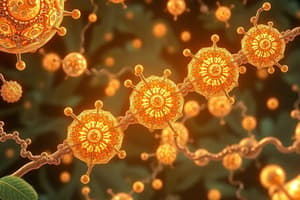Podcast
Questions and Answers
What is the primary function of transferases?
What is the primary function of transferases?
- Catalyze the hydrolysis of various bonds
- Catalyze isomerization reactions
- Catalyze the transfer of functional groups between molecules (correct)
- Catalyze the formation of bonds between two molecules
According to the lock-and-key hypothesis, what does the specific shape of enzymes allow them to do?
According to the lock-and-key hypothesis, what does the specific shape of enzymes allow them to do?
- Catalyze a wide range of reactions
- Bind to any substrate that comes in contact with it
- Change shape based on the substrate
- Fit specifically with their substrate like a lock and key (correct)
How do high temperatures affect enzyme activity?
How do high temperatures affect enzyme activity?
- Speed up enzyme kinetics without any negative consequences
- Decrease enzyme activity due to denaturation
- Increase enzyme activity until it reaches an optimal temperature (correct)
- Have no effect on enzyme activity
Which industry commonly uses enzymes in the production of insulin?
Which industry commonly uses enzymes in the production of insulin?
Why is it essential to maintain the optimal pH for enzymes to function correctly?
Why is it essential to maintain the optimal pH for enzymes to function correctly?
What is the primary function of enzymes in living organisms?
What is the primary function of enzymes in living organisms?
Which model describes the relationship between substrate concentration and enzyme activity?
Which model describes the relationship between substrate concentration and enzyme activity?
In enzyme classification, which category of enzymes catalyzes redox reactions?
In enzyme classification, which category of enzymes catalyzes redox reactions?
According to the lock-and-key hypothesis, enzymes:
According to the lock-and-key hypothesis, enzymes:
How does temperature affect enzyme activity?
How does temperature affect enzyme activity?
Flashcards are hidden until you start studying
Study Notes
Enzymes: The Catalysts of Life
Enzymes are proteins that act as biological catalysts, speeding up chemical reactions to sustain life's processes. They are essential to the functioning of living organisms as they help maintain cellular processes, metabolism, and growth. Let's delve into these fascinating molecules, uncovering their function, kinetics, classification, uses, the lock-and-key hypothesis, and their response to temperature and pH.
Function of Enzymes
Enzymes facilitate chemical reactions by lowering the activation energy required, making it easier for reactions to occur. Enzymes do not undergo significant changes during a reaction but remain active after the reaction is complete. By increasing reaction rates, enzymes allow organisms to carry out essential processes like digestion, respiration, and reproduction.
Enzyme Kinetics
Enzyme kinetics studies the relationship between enzyme concentration, substrate concentration, and reaction rate. Michaelis-Menten kinetics is a model that describes the relationship between substrate concentration and enzyme activity in terms of a saturation curve, the Michaelis-Menten constant (Km), and the maximum reaction rate (Vmax). The Model accounts for factors like enzyme saturation and the effect of substrate concentration.
Enzyme Classification
Enzymes are classified into six main categories based on the type of chemical reaction they catalyze:
- Oxidoreductases: Catalyze redox reactions.
- Transferases: Transfer functional groups between molecules.
- Hydrolases: Catalyze the hydrolysis of various bonds.
- Lyases: Catalyze the cleavage of bonds by non-hydrolytic mechanisms.
- Isomerases: Catalyze isomerization reactions.
- Ligases: Catalyze the formation of bonds between two molecules, requiring ATP as an energy source.
Enzyme Uses
Enzymes are used in various applications, such as:
- Food industry: In cheese production, baking, and brewing.
- Detergent industry: Break down stains during the washing process.
- Medicine: In the treatment of conditions like lactose intolerance, and in the production of insulin.
- Biotechnology: In genetics and biopharmaceuticals.
- Environmental applications: In wastewater treatment and the reduction of pollution.
Lock-and-Key Hypothesis
The lock-and-key hypothesis, proposed by Emil Fischer, suggests that enzymes have a specific shape that fits their substrate like a lock fits its key. This model implies that enzymes are highly specific and can only catalyze one or a few related reactions. Modern research has shed light on the dynamic nature of enzyme-substrate interactions, but the lock-and-key hypothesis remains a foundational concept.
Effect of Temperature on Enzymes
Enzymes have an optimal temperature at which they function most efficiently. As temperature increases, enzyme activity usually increases until reaching an optimal temperature, after which activity begins to decrease. High temperatures can lead to enzyme denaturation, a process that alters the enzyme's structure and function, rendering it inactive. On the other hand, low temperatures can slow down the enzyme's activity.
Effect of pH on Enzymes
Enzymes have an optimal pH at which they function most efficiently. This optimal pH varies among different enzymes, and it is essential to maintain optimal pH for enzymes to function correctly. Acidic or alkaline conditions can alter enzyme structure, leading to changes in activity and, ultimately, inactivation.
In summary, enzymes are essential proteins that act as biological catalysts, facilitating chemical reactions in living organisms. They are classified into six main categories, have specific uses in various industries, and are subject to the lock-and-key hypothesis model of action. Enzymes exhibit temperature and pH dependence, and their activity can be affected by changes in these factors.
Studying That Suits You
Use AI to generate personalized quizzes and flashcards to suit your learning preferences.





